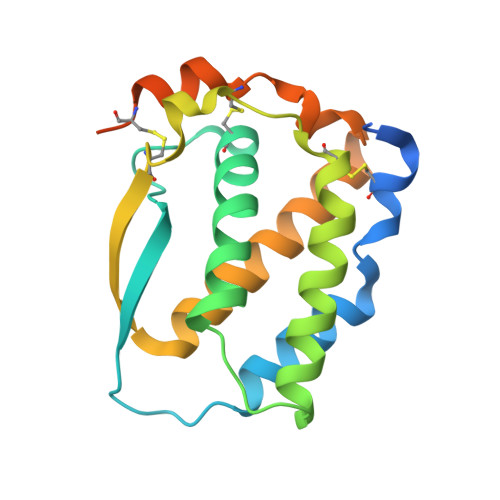Engineering a monomeric variant of macrophage colony-stimulating factor (M-CSF) that antagonizes the c-FMS receptor.
Zur, Y., Rosenfeld, L., Bakhman, A., Ilic, S., Hayun, H., Shahar, A., Akabayov, B., Kosloff, M., Levaot, N., Papo, N.(2017) Biochem J 474: 2601-2617
- PubMed: 28655719
- DOI: https://doi.org/10.1042/BCJ20170276
- Primary Citation of Related Structures:
5LXF - PubMed Abstract:
Enhanced activation of the signaling pathways that mediate the differentiation of mononuclear monocytes into osteoclasts is an underlying cause of several bone diseases and bone metastasis. In particular, dysregulation and overexpression of macrophage colony-stimulating factor (M-CSF) and its c-FMS tyrosine kinase receptor, proteins that are essential for osteoclast differentiation, are known to promote bone metastasis and osteoporosis, making both the ligand and its receptor attractive targets for therapeutic intervention. With this aim in mind, our starting point was the previously held concept that the potential of the M-CSF C31S mutant as a therapeutic is derived from its inability to dimerize and hence to act as an agonist. The current study showed, however, that dimerization is not abolished in M-CSF C31S and that the protein retains agonistic activity toward osteoclasts. To design an M-CSF mutant with diminished dimerization capabilities, we solved the crystal structure of the M-CSF C31S dimer complex and used structure-based energy calculations to identify the residues responsible for its dimeric form. We then used that analysis to develop M-CSF C31S,M27R , a ligand-based, high-affinity antagonist for c-FMS that retained its binding ability but prevented the ligand dimerization that leads to receptor dimerization and activation. The monomeric properties of M-CSF C31S,M27R were validated using dynamic light scattering and small-angle X-ray scattering analyses. It was shown that this mutant is a functional inhibitor of M-CSF-dependent c-FMS activation and osteoclast differentiation in vitro Our study, therefore, provided insights into the sequence-structure-function relationships of the M-CSF/c-FMS interaction and of ligand/receptor tyrosine kinase interactions in general.
Organizational Affiliation:
Department of Biotechnology Engineering and the National Institute of Biotechnology in the Negev, Ben-Gurion University of the Negev, Beer-Sheva, Israel.














